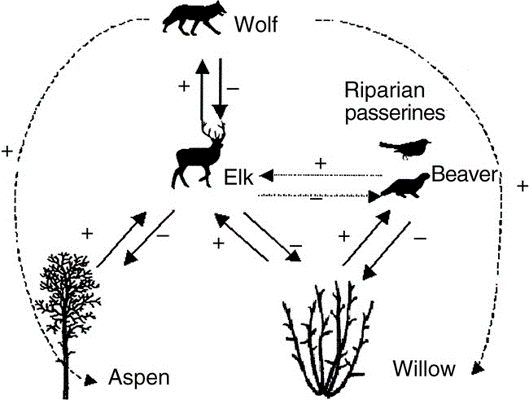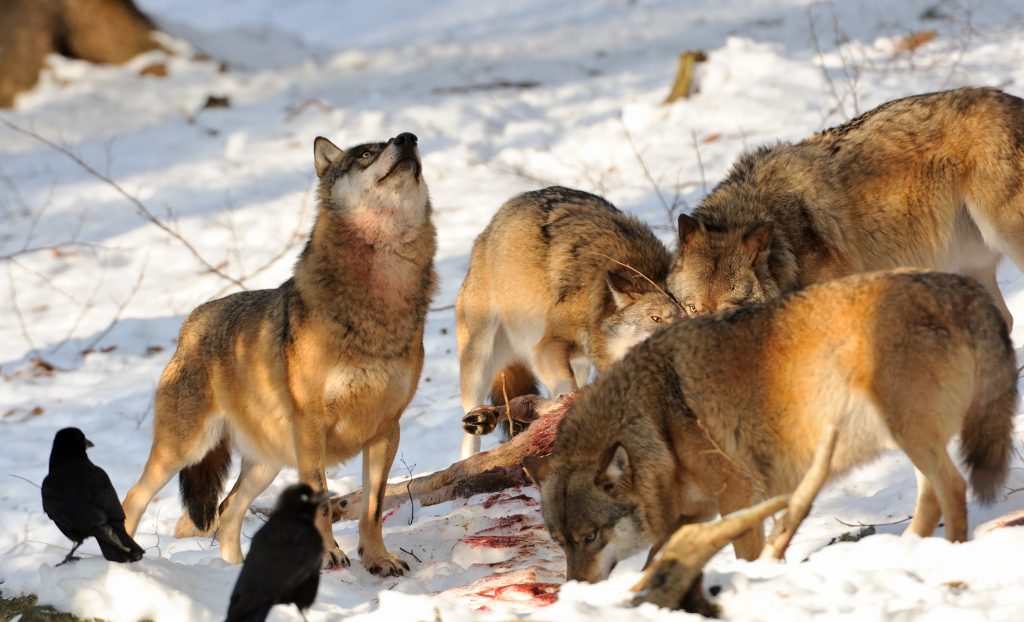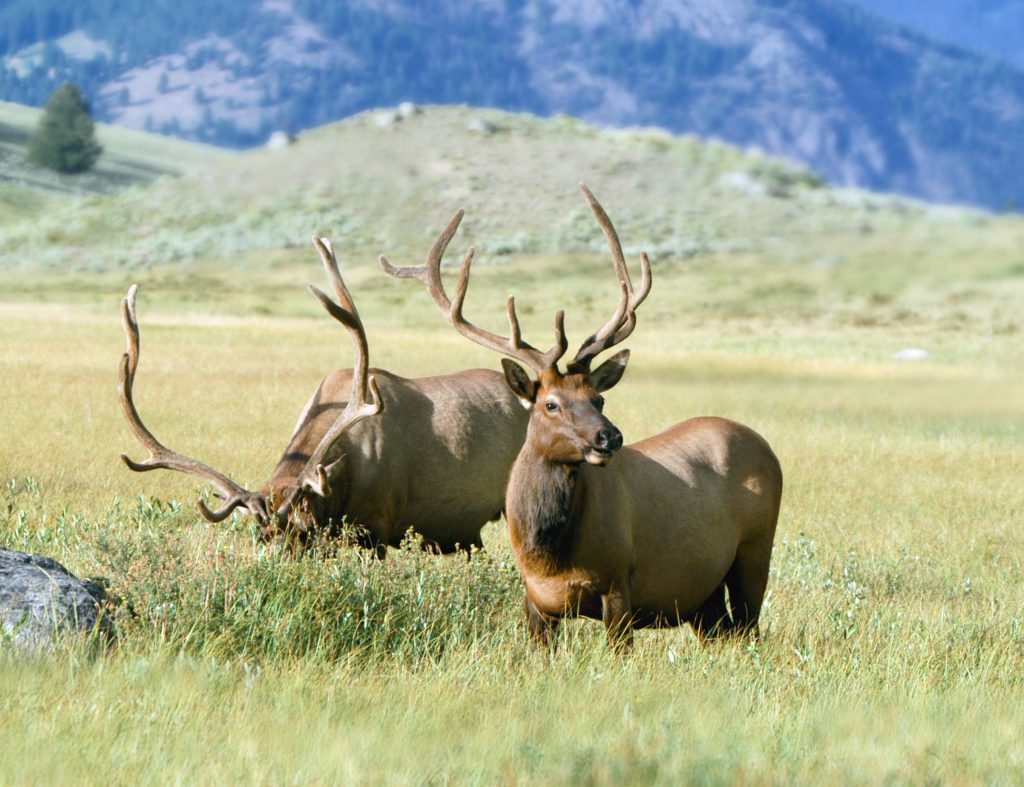by the Center for Human-Carnivore Coexistence (5/20)
Key Points….
- Wolves can generate trophic cascades – ecological effects that ripple through an ecosystem. In places like Yellowstone National Park, wolves have likely contributed to willow and aspen recovery and overall habitat diversity by reducing overbrowsing by elk.
- Wolves are likely not solely responsible for the changes in the Yellowstone ecosystem. Additional factors such as drought, harsh winters, other predators, and human hunting may have also helped reduce the Yellowstone elk herd and transform the ecosystem.
- Predicting the ecological effects of wolves is complicated, with no simple answers. Ultimately, if restored to Colorado, wolves might generate noticeable ecological effects where they occur in high enough densities for long enough time. In areas with lower densities of wolves, ecological effects will be less evident.
What is a Trophic Cascade?
Predators at the top of the food chain are known as apex predators. They can cause ecological effects that ripple through an ecosystem. These are called “trophic cascades”. A growing number of studies globally have documented trophic cascades generated by apex predators.1 Apex predators such as large carnivores are some of the first animals to decline or disappear when they share landscapes with people. Large carnivores are particularly susceptible because of their naturally low numbers, wide ranges, and active predator control by people. Their loss can have cascading effects that alter aquatic and terrestrial systems throughout the world.2
What are the ecological effects of wolves?
In short, it’s a complicated story with no simple answers.3,4 Multiple scientific studies have suggested that wolves, as apex predators, can have substantial ecological effects. Most such studies have been conducted in national parks such as Yellowstone and Isle Royale in the U.S. and Banff and Jasper in Canada.
In Banff National Park, development and human activity around the town of Banff kept wolf density low.5-6 Farther from town, wolf density was higher. When researchers compared low and high wolf density, they found fewer wolves led to increased elk numbers and greater browsing on willows and aspen (Figure 1). This in turn reduced habitat quality for songbirds and beavers.

Another study took place in Jasper National Park. 7 Scientists used historical records on wolf and elk numbers to suggest that elimination of wolves in the mid-1900’s led to increases in elk browsing and declines in aspen. Wolf recovery in the late 1960s apparently reduced elk use and allowed aspen to regrow.7
On Isle Royale National Park in northwestern Lake Superior, a research project ongoing for over 60 years has documented a unique predator-prey relationship between wolves and moose.4 Wolves are the only predator and primary cause of death for moose, which represent 90% of wolf diet. Wolf predation is an important influence on moose populations, indirectly impacting vegetation by altering moose browsing.4 However, since wolves colonized Isle Royale around 1949, the effects of wolves have varied over the years. Wolves have had strong effects during some periods but weaker influence during others. This is primarily because wolf numbers have fluctuated over time due to a variety of reasons, including prey abundance, weather, and disease.

Yellowstone National Park has been a focus of many studies on the ecological role of wolves. Elk represent about 90% of wolf diet in this area.4,6 Since the reintroduction of wolves in 1995, the elk herd in Yellowstone’s northern range has declined substantially. This has led some researchers to infer that wolves caused the decline.1,8,9 Wolves also can change the behavior of elk, causing them to move more and use habitat differently by seeking more cover.10-12 As in other parks, studies conclude that wolf predation can contribute to willow and aspen recovery, and overall habitat diversity, by reducing overbrowsing by elk, benefiting songbirds and beavers.1,8,10,11 Some studies also contend that willow and aspen recovery might change the flow of streams13-15, a topic that has gained considerable media attention.16 Other studies suggest that wolves can reduce coyote populations17 and thereby increase survival of pronghorn fawns upon which coyotes prey.18 Wolves also can benefit scavengers that feed on wolf kills such as bears, ravens, and eagles.6,19

However, some researchers have questioned if wolves are solely responsible for the changes evident in the Yellowstone ecosystem since wolves were reintroduced 25 years ago.3,4 They conclude that additional factors such as drought, harsh winters, other predators (bears and mountain lions), and human hunting also contributed to the decline of the Yellowstone elk herd. Experimental studies have not found strong evidence that wolves alone are driving regrowth of willow and aspen by changing elk behavior.20,21 Additional experimental evidence suggests that a reduction in overbrowsing alone is not sufficient to recover willows along some small streams.22 The overall benefit of wolves to scavengers also has also been challenged.3 Wolves eat most of the animals they kill, leaving scavengers the leftovers. Also, if wolves reduce prey numbers, fewer animals would die on their own and be available for scavengers to eat.
Overall, such studies emphasize that understanding trophic cascades in large complicated ecosystems is challenging.3,4 Although loss of predators can cause ecosystem-level impacts2, reintroduction of carnivores, including wolves, doesn’t always fully restore degraded ecosystems.23 In general, sweeping claims about trophic cascades caused by wolves are context-dependent and sometimes exaggerated.
What ecological effect might wolves have in Colorado?
The ecological effects of wolves are difficult to predict, particularly outside of national parks.3,4 In parks such as Yellowstone, wolves and their prey are typically protected from many human disturbances, such as hunting, predator control, and habitat loss. Within parks, wolves are more likely to occur in abundant, stable populations. This likely increases their ecological effects. Outside of parks, wolves are often more heavily impacted by people and their density is often lower. This might lessen their ecological effects.3
Ultimately, if restored to Colorado, wolves might generate ecological effects where they occur in high enough densities for long enough time. Wolves are more likely to cause ecological effects when they contribute to local reductions in prey populations, working in concert with other factors that also limit prey, such as adverse weather, habitat decline, other predators, or human hunting. In other areas with lower densities of wolves, the ecological effects of wolves will be less evident.
References
- Ripple, W.J., Estes, J.A., Beschta, R.L., Wilmers, C.C., Ritchie, E.G., Hebblewhite, M., Berger, J., Elmhagen, B., Letnic, M., Nelson, M.P. and Schmitz, O.J., 2014. Status and ecological effects of the world’s largest carnivores. Science, 343(6167), p.1241484.
- Estes, J.A., Terborgh, J., Brashares, J.S., Power, M.E., Berger, J., Bond, W.J., Carpenter, S.R., Essington, T.E., Holt, R.D., Jackson, J.B. and Marquis, R.J., 2011. Trophic downgrading of planet Earth. science, 333(6040), pp.301-306.
- Mech, L.D., 2012. Is science in danger of sanctifying the wolf? Biological Conservation, 150(1), pp.143-149.
- Peterson, R.O., Vucetich, J.A., Bump, J.M. and Smith, D.W., 2014. Trophic cascades in a multicausal world: Isle Royale and Yellowstone. Annual Review of Ecology, Evolution, and Systematics, 45, pp.325-345.
- Hebblewhite, M., White, C.A., Nietvelt, C.G., McKenzie, J.A., Hurd, T.E., Fryxell, J.M., Bayley, S.E. and Paquet, P.C., 2005. Human activity mediates a trophic cascade caused by wolves. Ecology, 86(8), pp.2135-2144.
- Hebblewhite, M., Smith, D.W., 2010. Wolf community ecology: ecosystem effects of recovering wolves in Banff and Yellowstone National Park. In: Musiani, M., L. Boitani, L., Paquet, P.C. (Eds.), The world of wolves: new perspectives on ecology, behaviour.
- Beschta, R.L. and Ripple, W.J., 2007. Wolves, elk, and aspen in the winter range of Jasper National Park, Canada. Canadian Journal of Forest Research, 37(10), pp.1873-1885.
- Ripple, W.J. and Beschta, R.L., 2012. Trophic cascades in Yellowstone: the first 15 years after wolf reintroduction. Biological Conservation, 145(1), pp.205-213.
- Creel, S., Christianson, D., Liley, S. and Winnie, J.A., 2007. Predation risk affects reproductive physiology and demography of elk. Science, 315(5814), pp.960-960.
- Ripple, W.J. and Beschta, R.L., 2004. Wolves and the ecology of fear: can predation risk structure ecosystems? BioScience, 54(8), pp.755-766.
- Beschta RL, Ripple WJ. 2013. Are wolves saving Yellowstone’s aspen? A landscape-level test of a behaviorally mediated trophic cascade: comment. Ecology 94(6):1420–25.
- Creel, S., Winnie Jr, J., Maxwell, B., Hamlin, K. and Creel, M., 2005. Elk alter habitat selection as an antipredator response to wolves. Ecology, 86(12), pp.3387-3397.
- Beschta, R.L. and Ripple, W.J., 2006. River channel dynamics following extirpation of wolves in northwestern Yellowstone National Park, USA. Earth Surface Processes and Landforms: The Journal of the British Geomorphological Research Group, 31(12), pp.1525-1539.
- Beschta, R.L. and Ripple, W.J., 2012. The role of large predators in maintaining riparian plant communities and river morphology. Geomorphology, 157, pp.88-98.
- Beschta, R.L. and Ripple, W.J., 2019. Can large carnivores change streams via a trophic cascade? Ecohydrology, 12(1), p.e2048.
- https://sustainablehuman.org/stories/how-wolves-change-rivers/
- Ripple, W.J., Wirsing, A.J., Wilmers, C.C. and Letnic, M., 2013. Widespread mesopredator effects after wolf extirpation. Biological Conservation, 160, pp.70-79.
- Berger, K.M., Gese, E.M. and Berger, J., 2008. Indirect effects and traditional trophic cascades: a test involving wolves, coyotes, and pronghorn. Ecology, 89(3), pp.818-828.
- Wilmers, C.C., Crabtree, R.L., Smith, D.W., Murphy, K.M. and Getz, W.M., 2003. Trophic facilitation by introduced top predators: grey wolf subsidies to scavengers in Yellowstone National Park. Journal of Animal Ecology, 72(6), pp.909-916.
- Kauffman, M.J., Brodie, J.F. and Jules, E.S., 2010. Are wolves saving Yellowstone’s aspen? A landscape‐level test of a behaviorally mediated trophic cascade. Ecology, 91(9), pp.2742-2755.
- Kauffman, M.J., Brodie, J.F. and Jules, E.S., 2013. Are wolves saving Yellowstone’s aspen? A landscape‐level test of a behaviorally mediated trophic cascade: reply. Ecology, 94(6), pp.1425-1431.
- Marshall, K.N., Hobbs, N.T. and Cooper, D.J., 2013. Stream hydrology limits recovery of riparian ecosystems after wolf reintroduction. Proceedings of the Royal Society B: Biological Sciences, 280(1756), p.20122977.
- Alston, J.M., Maitland, B.M., Brito, B.T., Esmaeili, S., Ford, A.T., Hays, B., Jesmer, B.R., Molina, F.J. and Goheen, J.R., 2019. Reciprocity in restoration ecology: When might large carnivore reintroduction restore ecosystems? Biological conservation, 234, pp.82-89.





